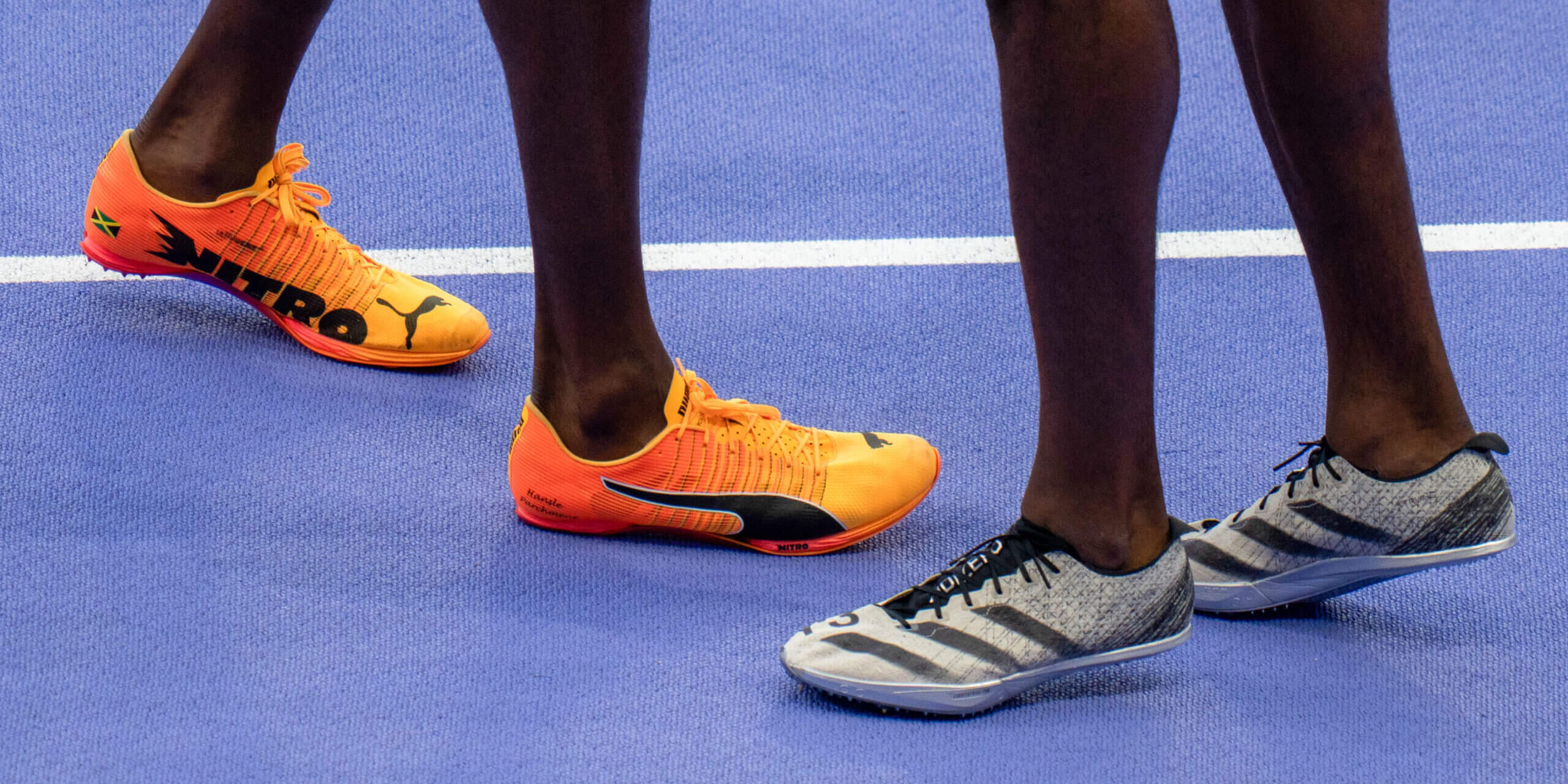
The Paris Olympics wanted a fast track and it got one – this is how it was made
- Sports
- August 13, 2024
- No Comment
- 104
There were two requirements for the Stade de France track for the 2024 Paris Olympics: make it purple and make it fast.
The colour was, in fittingly Parisian fashion, about creating a unique stage for athletes to perform. A lighter hue than the typical red tracks, following in the footsteps of the 2016 Olympics in Rio de Janeiro, where the track was navy blue and not red for the first time.
Making it faster is not as straightforward as a design choice. In fact, a ‘fast track’ has become the most hackneyed of athletics sayings — no host city is going to ask for a slow one, are they?
But Paris was fast: seven Olympic records and three track and field world records were set at the Games. This excludes world-best decathlon performances and field events (hammer throw, shot put), which do not use a runway or the track.
Combined, the number of Olympic/world records has trended upwards at recent Games: five in London (2012); six in Rio; 10 in Tokyo (2020) and the same again in Paris. It is an oversimplification that athletes are getting bigger, faster and stronger. Humans are also getting smarter and technology is getting better.
T&F Olympic/World records, Paris 2024
| Athlete(s) | Event | Nation | Record |
|---|---|---|---|
|
Team USA |
4x400m mixed relay |
USA |
World record |
|
Joshua Cheptegei |
10000m |
Uganda |
Olympic record |
|
Mondo Duplantis |
Pole vault |
Sweden |
World record |
|
Cole Hocker |
1500m |
USA |
Olympic record |
|
Winfred Yavi |
3000m steeplechase |
Bahrain |
Olympic record |
|
Arshad Nadeem |
Javelin |
Pakistan |
Olympic record |
|
Sydney McLaughlin-Levrone |
400m hurdles |
USA |
World record |
|
Marileidy Paulino |
400m |
Dominican Republic |
Olympic record |
|
Faith Kipyegon |
1500m |
Kenya |
Olympic record |
|
USA men |
4x400m |
USA |
Olympic record |
It was not just that records went in Paris, but how. Thirteen men ran quicker than Kenenisa Bekele’s 10,000m Olympic record from 2008 (27:01), with Uganda’s Joshua Cheptegei winning in 26:43.

Thirteen men ran under Kenenisa Bekele’s 10,000m Olympic record (Michael Steele/Getty Images)
Four men broke Jakob Ingebrigtsen’s 1500m Olympic record from Tokyo, including Ingebrigtsen, only for him to not medal. Four women broke Faith Kipyegon’s 1500m Olympic record, also from Tokyo, with Kipyegon winning in 3:51.

GO DEEPER
How the Ingebrigtsen-Kerr 1500m rivalry was pushed to new heights – even though neither man won
The women’s 400m final was the fastest ever, with all nine athletes going under 50 seconds. The men’s 100m final was the hardest to qualify for in Olympic history. Never before had a sub-10 second semi-final not guaranteed a spot.
The final itself was the deepest of all time, the only instance of all nine men going sub-10 in a wind-legal race, and the smallest first-to-eighth gap in a global final — 0.12 seconds separated Noah Lyles’ gold and Oblique Seville.
Similarly, the men’s 800m final was the first instance of four men running under 1:42 in the same race and that was a race where the Olympic record wasn’t broken.

The 100m final is the only instance of all nine men going sub-10 in a wind-legal race (Richard Heathcote/Getty Images)
Maurizio Stroppiana is the vice president of Mondo, an Italian company that produces synthetic athletics tracks. Mondo first made an Olympics track for Moscow in 1980, 12 years and three Games after they were first introduced at Mexico City in 1968. Mondo have manufactured every track since Barcelona in 1992.
“Mondo tracks are known to be the fastest in the world, with 300-plus records to date and over 70 per cent of all current records,” says Stroppiana.
If you think numbers like that mean Mondo have cracked the science of making quick tracks, they kind of have, but the science is less perfect than you might expect. Mondo’s tracks are made from “vulcanised rubber”, says Stroppiana.
When Paris hosted the Olympics in 1924, it was on a cinder track. “It was like dirt,” explains Stroppiana. “So, apart from getting dirty, it was more like running in a field as opposed to running on a 400m (synthetic) track”.
‘Fast tracks’ is something of a misnomer. The athlete is fast (or not), it is about making a track efficient. “We are trying to minimise the energy that is lost. The track compresses (as the foot hits the track) and it will then return that energy in the most efficient way, although a part of it will certainly be lost,” says Stroppiana.

The 1968 Olympics in Mexico City was the first to use a synthetic track (AFP via Getty Images)
Athletes produce around three times their body weight in vertical force when running. How much of that is translated into horizontal force — them moving forwards — depends on the “braking and propulsive forces”, Stroppiana says.
Mondo implemented “elliptical air cells within the base layer of the track”, which they found to have a double benefit: a 2.6 per cent increase in net horizontal energy return, and a 1.9 per cent improvement in shock absorption.
It is about protecting athletes while trying to maximise performance, though those things are interrelated. “The track has to provide a certain level of comfort and cushion,” says Stroppiana.
He outlines that the determinants of maximal energy return are the “type of material, the elasticity of the material. We have these aerosols on the bottom of the track. That helps the cushioning effect and how that energy is returning as equally as possible”.
“What we noticed in the previous track (Tokyo) is that, depending on where the athlete stepped (with the foot), you get different results. We modified the shape to provide a more uniform response and to increase the area of depression of the track,” says Stroppiana.
“This makes the track better because they will not feel any difference, the elastic response is exactly the same throughout the track to guarantee that the rhythm of the athlete (will) be maintained.”
If that sounds straightforward and simple, it isn’t. Stroppiana says “it took us about two years to fine-tune this new solution. We developed this mathematical model at the University of Milan”. It lets them run simulations and test new combinations faster. The four-year Olympic cycle gives ideal preparation time.

Washing the Olympic track in Tokyo in 2021 (Antonin Thullier/AFP via Getty Images)
One myth Stroppiana is keen to bust is track hardness. “These narratives started in the 1996 (Atlanta) Olympic Games because they had some great record times,” he says. “They started saying, ‘Yes it’s fast, it’s fast because it’s hard’. And since then we haven’t been able to change that point of view.”
How hard is the Paris track? “It’s softer than before,” says Stroppiana. “We really came to realise that is not a good solution making the track hard. And also, (it) doesn’t necessarily translate into faster times. In fact, it can actually lead to injury. So we have changed that in the last, six, seven years.”
They use a lower-carbon production method and more sustainable materials now than before, including calcium carbonate from mussel shells.
Unsurprisingly, it isn’t cheap. Stroppiana prices the Paris track at “anywhere from two to three million”, explaining that the top synthetic part “is only 14 millimetres thick. It’s quite thin”. He says that tracks tend to last around 15 years before needing replacement or relaying.

Mondo manufactured Rio’s blue track for the 2016 Games (Patrick Smith/Getty Images)
Decades of academic research detail the impact of altitude (positively for sprints, with the reduced air resistance; negatively for distance running, with the reduced oxygen) and wind.
The 1968 Olympics had the added impact of being the highest-altitude summer Games ever, at over 2,000m (7,000 feet). Sprinting and jumping records were smashed to pieces. Of the 12 sprint events, only the women’s 400m did not see an Olympic or world record, but distance races were slow.
Sprint performances over 1,000 metres are not considered legal and ‘altitude-assisted’, with a following wind of up to two metres the threshold for wind-legal sprint performances.
It means a good track needs the right location to be optimal for (legal) records. Saint-Denis, where Stade de France is situated in northern Paris, is within 50 metres of sea level. Stroppiana talks about the stadium creating a “microclimate” to “provide more favourable (performance) conditions”.
He explains that “the stadium’s architecture, including its oval shape and partially covered roof, helps to reduce wind interference. The stadium’s seating arrangement and the height of the stands contribute to shielding the track”.
Looking ahead, the 2028 Games in Los Angeles, USA, and the 2032 Games in Brisbane, Australia, are both in coastal cities.

The Stade de France’s ‘microclimate’ provides favourable conditions for fast times (Richard Heathcote/Getty Images)
For Stroppiana, the future of track-making lies in Mondo working with shoe/spike brands, who are notoriously “secretive about their own knowledge. Now there is this movement toward open innovation, which means collaborating within an industry, but not through competing brands”.
“I think the next evolution of the track surfaces is to make adjustments for these different (field) disciplines — an area of improvement for all the runways,” says Stroppiana.
He went on to say that Mondo works with Adidas, Nike, Asics, ON and Puma, among others, and collaborated with the latter for Paris.
“Before Tokyo, we worked with Asics because they gave us some insight. We installed our track at their research laboratory and they were testing different types, different solutions, to see which one (track) would be best.
“They do their own evaluation and they try to make sure that the (track/spike) interaction is as good as possible, concerned about how the spike will grab onto the surface, which is critical.”
Different events require different length spikes. Stroppiana speaks of 400m spikes having “different properties on the right-hand side” to aid bend running (as the outside of the foot hits the track first on landing and athletes run around to the left).
There is a trade-off to be achieved: Mondo “want to guarantee the proper traction but minimise the friction. So if the spikes were to penetrate too much on the surface, then it slows the athletes down”, says Stroppiana. “This is one of the characteristics of the top wear layer: it has to be spike resistant.”
Exceptions from that are pole vault and javelin because athletes are moving with so much force that the spike needs to penetrate the surface to avoid injury.
“In Paris, if you look closely at the javelin runway, the last portion is slightly different in colour (to the track)” says Stroppiana. “Why? Because that section has been specifically engineered for javelin throwers. We worked with the German team and the Finnish team to test different solutions”. He says they wanted a runway with “more spike resistance and to have a better grip.
“Normally the track has to be the same. You cannot have different properties for different areas. But for javelin, they (World Athletics) accepted these changes.” It worked: Pakistan’s Arshad Nadeem smashed the Olympic record by over 2.5m, throwing 92.97m, to earn Pakistan’s first athletics gold.
Stroppiana is optimistic about a future with more adjustments. “For the long distance, you could create a section where it’s specifically made,” he says, suggesting an inside lane. “In fact, we have done some tracks like this — only for training, not for competition — where you have a differentiated elastic response”.
There’s no doubt the 2028 LA track will be even more efficient. Mondo have four years to test and re-test new combinations and spike brands to work with. The main question that remains is: what colour will it be?
(Top photo: Nathan Laine/Bloomberg via Getty Images)
#Paris #Olympics #wanted #fast #track









